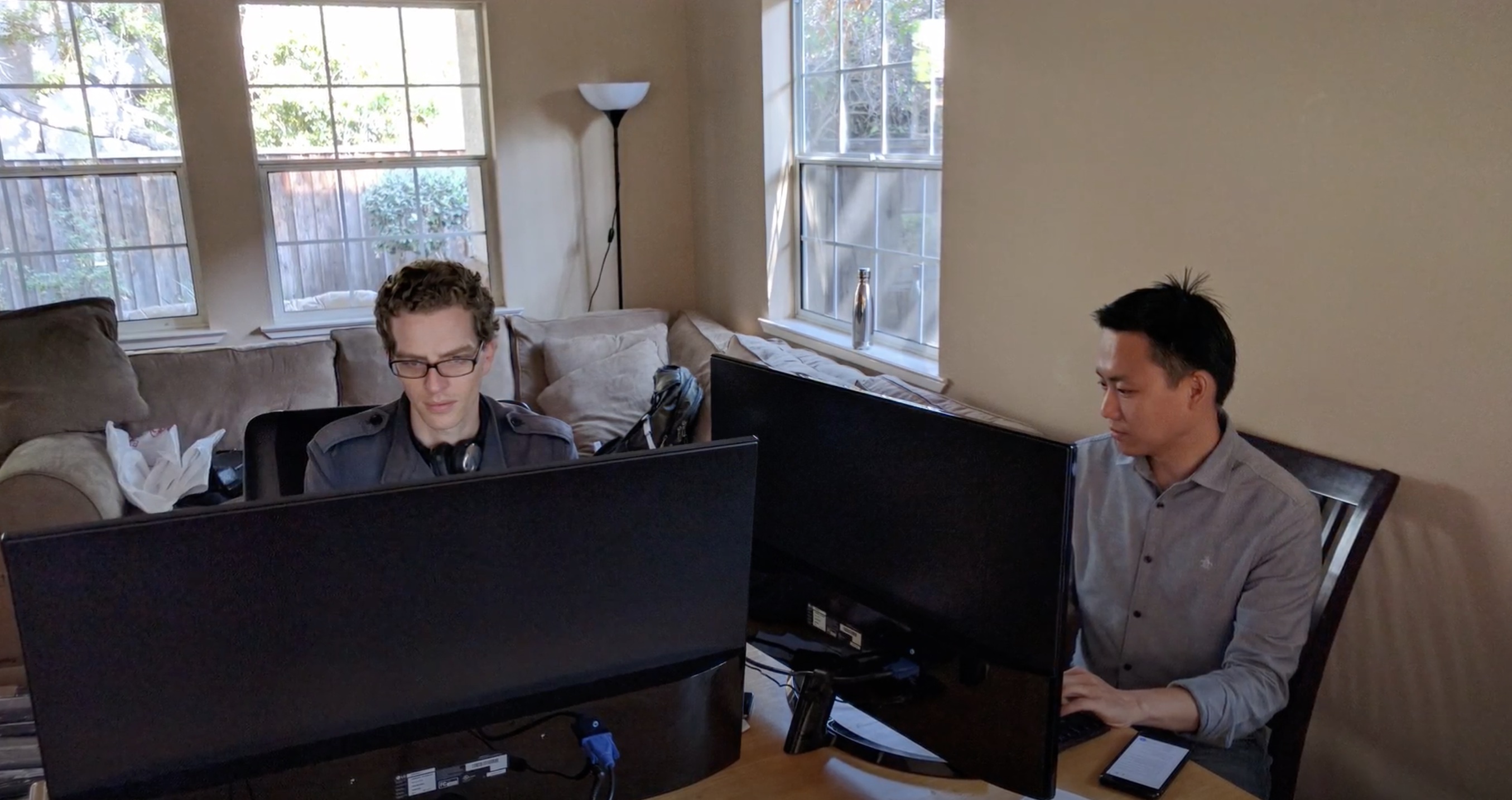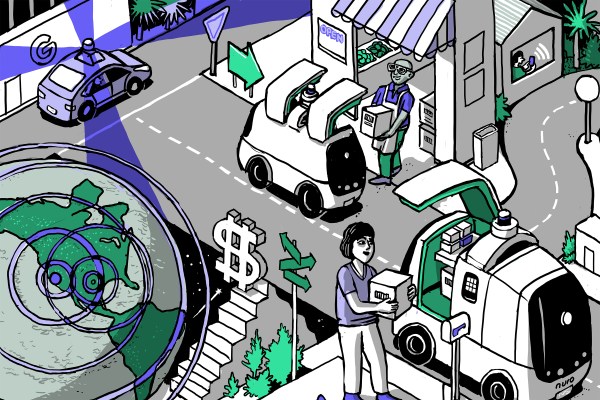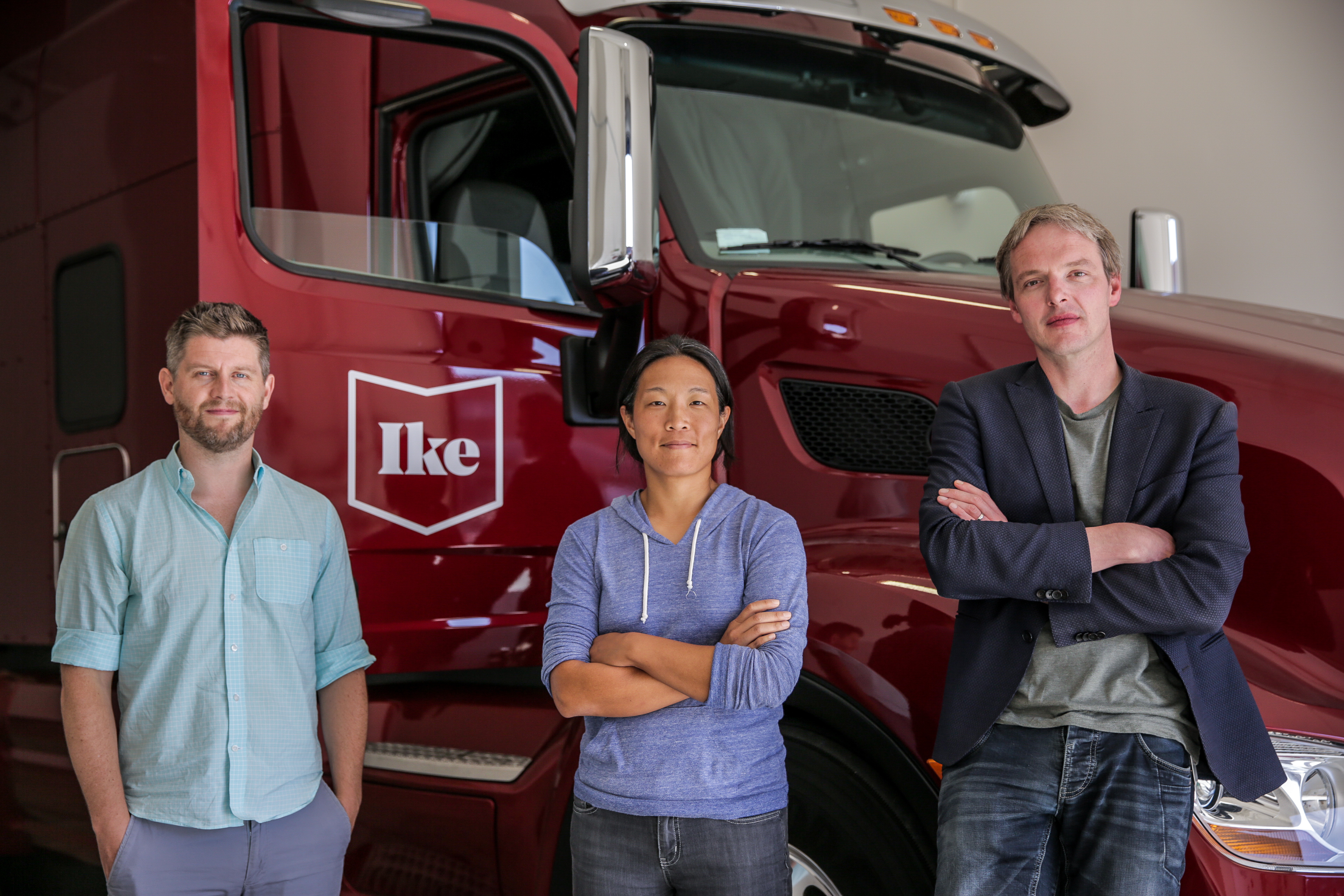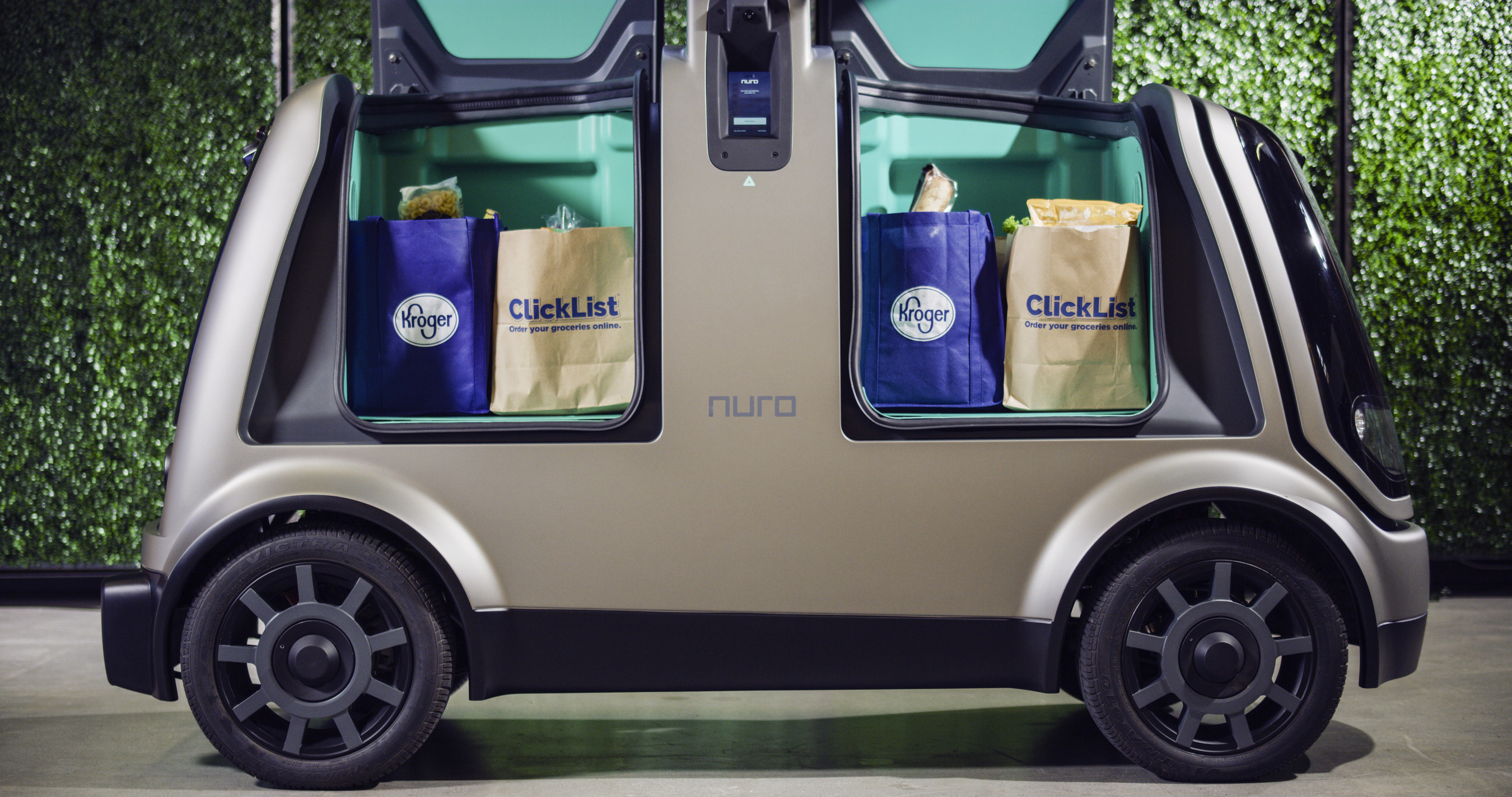Nuro doesn’t have a typical Silicon Valley origin story. It didn’t emerge after a long, slow slog from a suburban garage or through a flash of insight in a university laboratory. Nor was it founded at the behest of an eccentric billionaire with money to burn.
Nuro was born — and ramped up quickly — thanks to a cash windfall from what is now one of its biggest rivals.
Nuro was born — and ramped up quickly — thanks to a cash windfall from what is now one of its biggest rivals.
In the spring of 2016, Dave Ferguson and Jiajun Zhu were teammates on Google’s self-driving car effort. Ferguson was directing the project’s computer vision, machine learning and behavior prediction teams, while Zhu (widely JZ) was in charge of the car’s perception technologies and cutting-edge simulators.
“We both were leading pretty large teams and were responsible for a pretty large portion of the Google car’s software system,” Zhu recalls.
As Google prepared to spin out its autonomous car tech into the company that would become Waymo, it first needed to settle a bonus program devised in the earliest days of its so-called Chauffeur project. Under the scheme, early team members could choose staggered payouts over a period of eight years — or leave Google and get a lump sum all at once.
Ferguson and Zhu would not confirm the amount they received, but court filings released as part of Waymo’s trade secrets case against Uber suggest they each received payouts in the neighborhood of $40 million by choosing to leave.
“What we were fortunate enough to receive as part of the self-driving car project enabled us to take riskier opportunities, to go and try to build something that had a significant chance of not working out at all,” Ferguson says.
Within weeks of their departure, the two had incorporated Nuro Inc, a company with the non-ironic mission to “better everyday life through robotics.” Its first product aimed to take a unique approach to self-driving cars: Road vehicles with all of the technical sophistication and software smarts of Google’s robotaxis, but none of the passengers.
In the five years since, Nuro’s home delivery robots have proven themselves smart, safe and nimble, outpacing Google’s vehicles to secure the first commercial deployment permit for autonomous vehicles in California, as well as groundbreaking concessions from the U.S. government.
While robotaxi companies struggle with technical hitches and regulatory red tape, Nuro has already made thousands of robotic pizza and grocery deliveries across the U.S., and Ferguson (as president) and Zhu (as CEO) are now heading a company that as of its last funding round in November 2020 valued it at $5 billion with more than 1,000 employees.
But how did they get there so fast, and where are they headed next?
Turning money into robots
“Neither JZ nor I think of ourselves as classic entrepreneurs or that starting a company is something we had to do in our lives,” Ferguson says. “It was much more the result of soul searching and trying to figure out what is the biggest possible impact that we could have.”
Ferguson’s original plan, in his home country of New Zealand, was to become a lawyer. While studying at the University of Otago, he took computer science and math courses where he worked on the perception and controls systems for a trashcan robot. He became “totally hooked” and moved to Carnegie Mellon University for a doctorate in robotics.
There, Ferguson was involved in the DARPA Urban Challenge, a 60-mile obstacle course on city streets for autonomous vehicles in 2007. CMU’s entry, a heavily modified Chevy Tahoe called Boss, ultimately won first place and a $2 million prize. The victory, however, came at a price: Ferguson was so burned out, he ended up taking a job as a machine learning quant at a hedge fund to de-stress: “It was a huge moment for me and for the industry, but I felt I needed a break.”
Meanwhile, Zhu had moved from his native China to study for a master’s at the University of Virginia. His first job out of college in 2008 was working on computer vision problems for Google’s Street View team, where he met Anthony Levandowski and Sebastian Thrun.
“Six or seven months in, Sebastian comes to me and said, ‘Hey, we have this secret robotics project. Would you like to be part of it?” Zhu says. “Of course, I said yes. Building intelligent machines with Sebastian and getting paid is the best job in the world.”
A couple of years later, Ferguson was tempted back into the self-driving world by some of his CMU colleagues and found himself seated besides Zhu. “And we’ve been sitting next to each other for the last 10 years,” Ferguson laughs.
Google’s self-driving car team swelled from just a few engineers in 2009 to dozens and then hundreds within a few years. By the time they had to make their Chauffeur bonus decision in 2016, the duo felt ready for a new challenge.
“Waymo had this very clear focus on transportation, but I felt it was good timing to start a robotics company that focuses beyond that,” Zhu says. “If you think about how we interact with the physical world, we spend a ton of time cooking, doing laundry and cleaning just like our parents and grandparents did. At Nuro, we want to change how people spend their time.”
From people to packets
Ferguson and Zhu moved into an Airbnb behind the train station in Mountain View, a few miles from Google’s campus. “No one would rent corporate real estate to us because we were an unknown entity,” remembers Cosimo Leipold, an early employee and now Nuro’s head of Partnerships. “So the first thing we would have new employees do is remove a bed from one of the rooms and put together their own desk.”
Nuro was a robotics company from day one, according to Ferguson. The crux: Picking the right bot to build.
“It’s not about self-driving. It’s not about delivery. It’s about broader robotics. The question is: What is the most useful robot we can build that could really help people in their day-to-day life?” says Ferguson. Unusually for Silicon Valley, the team Ferguson and Zhu put together to answer that question was evenly split between engineers and non-engineers.
Their best answer, with existing technologies, was a delivery autonomous vehicle (AV).

Nuro co-founders Dave Ferguson (left) and Jiajun Zhu in their first office, an Airbnb. Image Credits: Nuro
An insight to boost safety and convenience
Research commissioned by Nuro estimates that electric delivery AVs could replace about a quarter of all vehicular shopping and errands trips by 2035. This in turn could avoid over 350,000 injuries and deaths, reduce CO2 emissions equivalent to taking 88 million cars off the roads, save 21 billion hours of driving time and generate over $4 trillion in overall economic benefits. While the first grocery deliveries using Nuro cost customers $6, the company hopes the efficiency of robotic delivery will ultimately eliminate any additional cost altogether.
Ferguson and Zhu realized that instead of redesigning the passenger car to operate without a driver, AV makers should be redesigning the driving process so that people don’t need to make a journey in the first place. It’s an insight that seems obvious after a year’s worth of pandemic lockdowns, but Nuro remains one of the very few companies focused on zero-occupancy autonomous vehicles (ZOAVs).
“One of the fundamental reasons why passenger self-driving is so difficult is that you’re constantly trying to balance safety and comfort,” Ferguson says. “The bar is very high to keep passengers comfortable, whereas if you’re driving a bottle of milk or a burrito, you can focus entirely on safety.”
Nuro’s vehicles are routinely programmed to take the safest routes, even if it means a longer or slower journey. Its latest vehicle, the R2, has a collapsible front end and airbags. Nuro also received a patent in early 2021 for a rapid-stopping technology that allows a vehicle to stop 15 times faster than a typical passenger car. That technology is not deployed in the R2.
“This is one of my favorite inventions,” Ferguson says. “It basically fires bolts into the road below to decelerate from 25 miles per hour to a stop in just a few feet. That would be incredibly uncomfortable for a person, but all we’re hurting are some eggs.”
However, the development process did have its victims, remembers Leipold. “Our very first activity as a team was building a bright neon green cart with a particleboard front glued on and loaded up with sandbags. We would take turns pushing the cart as fast as we could at someone standing in front to see how much it would hurt,” he says.
The final vehicle is about 9 feet long, shorter and narrower than a subcompact vehicle, further reducing sideswipe risks, and limited to a top speed of 25 mph. There are two customizable cargo compartments, together offering more cargo capacity than a Tesla Model 3. Like Google’s self-driving cars, it is also home to a full suite of sensors, including 360-degree laser-ranging lidars, radars and several video cameras.
While the R2 can drive itself competently within a well-mapped area, a human “guardian operator” in a nearby operations center monitors its performance and can take control at any time.
“We’re confident that this is going to be the next major leap forward in on-road safety, in even a more dramatic sense than [the benefit] we got from seat belts and air bags,” Ferguson says.
Turning robots into money
Nuro’s vision struck a chord with investors. Just a few months after its launch, Nuro raised its first Series A from NetEase founder Ding Lei (aka William Ding) in China. Ding was China’s first internet and gaming billionaire, and was reportedly once the wealthiest person in China. A second, U.S.-based round led by Greylock Partners in June 2017 raised Nuro’s total Series A funding to $92 million.
Greylock had been interested in AVs for some time, but took a fairly skeptical view of the technology. “We thought optimism for AVs changing the world was off the charts,” says John Lilly, venture partner at Greylock Capital and now a Nuro board member. “But on almost every call we had with anybody who knew anything, they said we should definitely talk to JZ and Dave. They won’t tell you what they’re doing, we were warned, but they’re awesome.”
It took a sustained effort to get into Nuro’s Airbnb digs, and even then Ferguson and Zhu only pulled back the curtain “a little bit,” remembers Lilly. But Greylock was convinced by the little they did see. “The approach of having no people in the car was a highly differentiated point of view, and it’s not what anybody else was doing at the time,” he says. “We were blown away by the progress they had made in just over a year on their own. They looked like a fully formed technology company.”
Nuro was also growing like one. In early 2018, Nancy Sun, Jur van den Berg, and Alden Woodrow joined Nuro from the wreckage of Uber’s self-driving truck project. While they were officially Nuro employees, their intent was to license the company’s technology and apply it to highway trucks.
“We [were] always looking for opportunities where the tech that we’ve built could help,” Ferguson told TechCrunch in 2019. “Trucking was a really good example, but we recognized that as a company, we couldn’t spread ourselves too thin. It made sense for both sides for [Nancy, Jur and Alden] to build their own independent company.”
Four months later, the trio left Nuro to found Ike, taking with them a license to use Nuro’s hardware designs and autonomous software, as well as data logging, maps and simulation systems, in exchange for a minority stake in the new startup.
But it was SoftBank’s shockingly large $940 million Series B investment in early 2019 that really put Nuro on the map.
“We spent some time with Masa[yoshi Son, SoftBank CEO] who had this really amazing way of describing the future,” Zhu recalls. “He said to us that the future is a big vending machine where people can just say what they want and things will automatically get delivered to them. And he sees Nuro as a very important part of that future. That vision alignment was just what we were looking for.”
SoftBank also has so many relationships with many different companies around delivery and transportation that there will be lots of ways for the organizations to work together, Lilly noted.
Nuro’s fundraising strategy then evolved to support the founders’ grander ambitions. “The self-driving industry is very capital intensive, so having enough money is a very important way of de-risking the company,” Ferguson says.
The investors in the company’s next round, a $500 million Series C in November 2020, reflects that change. The round, which pushed Nuro’s valuation to $5 billion, was led by T. Rowe Price Associates and saw participation from Fidelity Management & Research Company, Baillie Gifford, Chipotle and Toyota’s innovation-focused subsidiary, Woven Planet.
“We saw our Series C as a great opportunity to raise a strong round in terms of the total amount, but, perhaps more importantly, to start developing relationships with investors that could be part of our journey for now, forever,” Ferguson says. “T. Rowe and Fidelity are investors that will invest through an IPO and beyond.”
Just as important for Nuro has been its commercial partnerships, where Nuro has had pilot delivery projects with retailer Fry’s Food, a subsidiary of its grocery store chain partner Kroger, CVS pharmacies, Domino’s, FedEx and investor/partner Chipotle. At first this involved modified autonomous Prius cars with safety drivers, but Nuro recently started deliveries using the driverless R2.
Like Waymo’s autonomous ride-hailing service in Phoenix, Nuro intends to focus on providing autonomy as a service rather than selling its vehicles for the foreseeable future. “If you think about the complexity of the tech we’re building, it would be difficult to hand that off in the early years,” Ferguson says. “Long term, I think there’s more flexibility. You can imagine partners doing maintenance, servicing and maybe housing the bots.”
The road ahead
While there are dozens of companies building passenger AVs, Nuro now finds itself in the odd position of having almost no competitors dedicated to on-road ZOAV delivery in the United States. Refraction AI just started pizza deliveries in Austin, Texas, using a robotic electric tricycle that weighs 10 times less than the R2 and travels in bike lanes or on road shoulders at under 15 mph.
Refraction’s REV-1 bot has some autonomy on board but relies heavily on teleoperators to ensure it behaves well on the move. “There’s definitely some daylight between the companies,” says Refraction CEO Luke Schneider. “Nuro is developing first-rate perception, AI and autonomous technology. We have a view that’s almost on the other end of the spectrum. We’re trying to build the de facto standard for last-mile delivery: Practical, affordable and sustainable.”
There is also nascent competition from the very well-funded legacy AV companies — both Waymo and Cruise have launched delivery projects and pilots.
But neither worries Ferguson and Zhu too much. “For almost all of the large self-driving companies, making sure that they are in the hunt for the passenger market is an existential threat,” Ferguson says. “We have an advantage by being able to laser focus on delivery, whereas for other self-driving companies, goods is just one of several applications that they may or may not want to take on in the future.”
Even when they do turn their attention to delivery, Nuro thinks it has a head start in relations with retailers, investors, and especially regulators, who have looked favorably on the company’s requests for operations and hardware exemptions, like removing unnecessary wing mirrors and windshields from their vehicles.
“Right now, everyone is racing to build a product. If you look a decade out, I don’t think there will be 10 companies competing, because it’s too hard to build this product,” Zhu says. “But if there are three or four companies sharing a trillion-dollar opportunity, that’s a pretty good place to be.”
That consolidation has already started, close to home. In December of last year, Ike returned to the Nuro fold, bringing with its 55 employees and nascent relationships with trucking companies like DHL, Ryder and NFI.
“What is particularly compelling for Nuro is … there’s a shared DNA,” Ferguson told TechCrunch at the time of the acquisition. “The tech that they built is also something that we can very readily transfer over and almost plug and play into our system.”
Unlike much of the tech ecosystem, which provides products and services for corporates and rich consumers, Nuro wants to stay focused on delivering value from the bottom up. Its grocery delivery pilot in Houston started in a majority Black and historically underresourced area, and the company plans to eventually drive the cost of its delivery services down to zero.
“We’ve never been interested in building really cool gadgets or toys for the very well-off,” Ferguson says. “It’s always been about the path that we could take as individuals and as a company toward trying to do something big and meaningful in the world.”
“Dave and JZ are just spectacular as thinkers and technologists and product people and leaders,” says Lilly. “Building a company from scratch with its own software stack, its own hardware stack and its own service is almost impossible. But if you can do it, then you have control and an ability to deliver a product that’s superior across the experience. It requires exceptional operating talent and a bunch of capital coming together, and that’s what I think we have here.”
Of course, the company still has to generate excitement and raise the funds to build tens of thousands — or more — bots. Nuro has a mission of “constant growth,” both geographically, expanding from its small-scale pilots in California, Arizona and Texas, as well as technologically, with new vehicles and systems on its roadmap. New partnerships are set to be announced this year, and the company is engaging with state and federal governments to craft sensible, scalable regulation.
One such expansion appears to be taking shape in Nevada, according to public records. Those plans include a dedicated off-road testing center, allowing the company to see how its bots deal with edge cases, such as kid’s soccer balls rolling into the road or monster potholes. Previously unreported testimony to Nevada officials reveals that the state could also become home to a new teleoperations facility, as well as Nuro’s first bot assembly plant.
“In the five years since we started the company, sticking to grand missions that sound very altruistic is difficult, because there’s a lot more skepticism around what are you really doing it for?” Ferguson says. “But we really believe that in the next 10 to 15 years, we’re going to see a huge wave of innovation, where generation-defining iconic companies will be created in the robotic space. That’s what we want Nuro to be.”
That wave of technological innovation, however, won’t go far if governments don’t look inward and revamp regulations to let companies like Nuro develop new products and services. But Nuro has that part of the challenge more or less in the bag, as we’ll see in part two of this EC-1.
Nuro EC-1 Table of Contents
- Introduction
- Part 1: Origin story
- Part 2: Regulations
- Part 3: Partnerships
- Part 4: Operations
Also check out other EC-1s on Extra Crunch.


